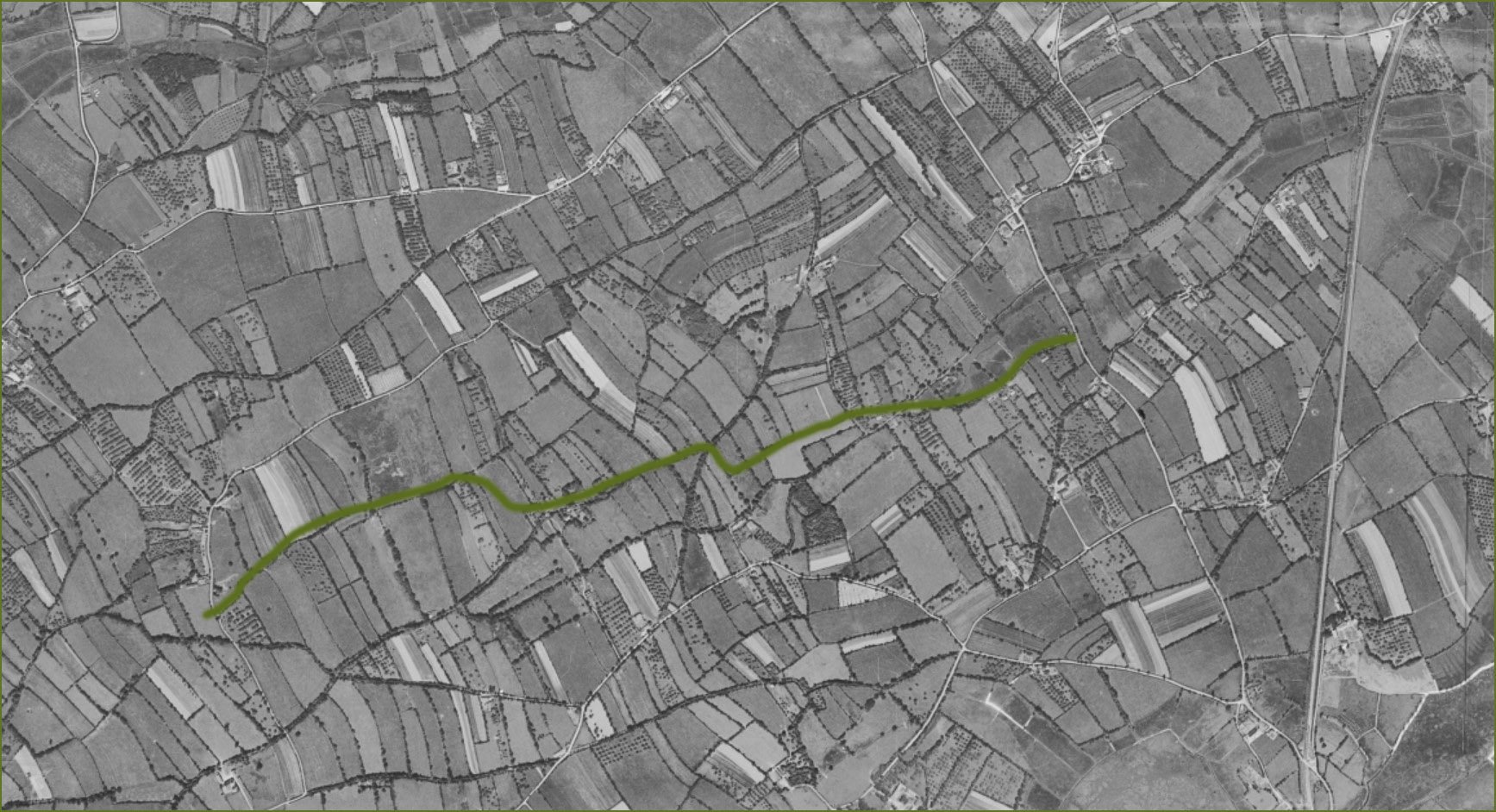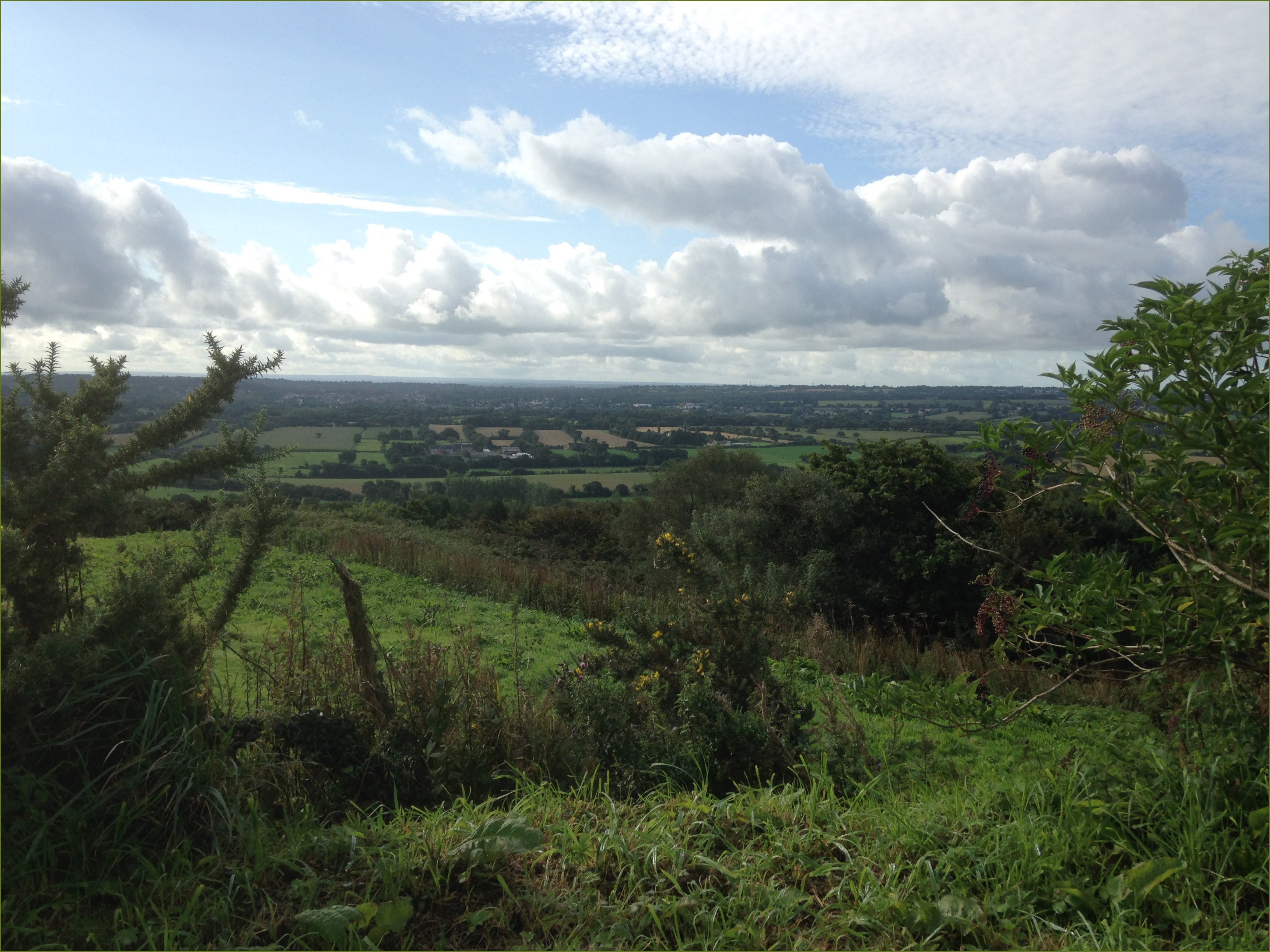June 29th, 1944, while the last battles were taking place west (Cap de la Hague) and east (Cap Lévi) of Cherbourg, the 2nd Battalion of the 314th Infantry Regiment left its assembly area (south of Bricquebec) to take up a defensive position, northwest of Hill 121, along the Douve river just southeast from Saint-Sauveur-de-Pierrepont.
By 0830pm, companies were hidden in their foxholes:
- "G" Company on the right.
- One platoon of "E" Company on the right flank of "G" while the rest of "E" was in reserve.
This defensive position was a line running from coordinates 122895 to 140900 (see map below).
 ©2023IGNMap.com
©2023IGNMap.com
The 2nd Battalion was the first to leave the assembly area, the rest of the regiment left it on the 30th of June 1944 for a new one southwest of Besneville, precisely around the regimental command post, established at coordinates 109917.
La Haye-du-Puits outskirts
At 0945am on July 2nd, Regimental’s Commander, Colonel Warren A. Robinson received an order from Division’s Headquarter telling him to have his men ready for an attack on Hill 121 scheduled at 0350pm (see photo below). H-Hour was finally postponed to 0530am on July 3rd .
 Hill 121 also know as Mont Doville
Hill 121 also know as Mont Doville
At 0700pm, a meeting was held in preparation of the incoming attack, Colonel Robinson was honored of the Silver Star by General Ira T. Wyche for gallantry in action during the Cherbourg Campaign. In the meantime, “C” Company moved out of its line of departure which was running from coordinates 104891 to 143904.
July 3rd, 1944 at 0515am, an artillery barrage took place fifteen minutes before the men assaulted Hill 121. 1st Battalion, under Lieutenant-Colonel Olin E. Teague’s command was assigned the objective of taking the ridge southwest of Hill 121 which had the purpose to protect the 3rd Battalion’s left flank. Under the rain, it crossed the line of departure at exactly 0530am, men advanced approximately one-half mile before machine gun and mortar fire were encountered. 3rd Battalion was echeloned on the left rear of 1st Battalion.
Around 0830pm, as darkness was falling, the 3rd Battalion’s men were ordered to turn off the route of advance of the 1st Battalion and then to push to the east to seize Hill 121. Radio contact was lost until 0230am on July 4th when an artillery liaison officer reported the battalion to be approaching its objective.
At coordinates 154870, in his forward observation point, Lieutenant-Colonel Teague, was wounded by a bullet which ended its race in his right shoulder. Refusing to leave the frontlines, he assumed command until 1115pm when the order to dig in for the night arrived.
Note: 2nd Battalion was staying in defensive positions to provide a supporting fire on the west slope of Hill 121.
Once radio contact was regained between both battalions, it was learned that the 3rd Battalion had taken its objective at 0330am. It was badly harassed but no heavy German resistance was encountered.
Note: 2nd Battalion crossed Douve River at 0230am and occupied the north and northeast of Hill 121 by 0730am.
Once Hill 121 was taken, the 314th Infantry Regiment was ordered by Division’s Headquarter to continue its attack in the area. The 2nd Battalion passed thru the 1st Battalion’s positions toward La Haye-du-Puits, the 1st Battalion by the village of Bolleville while the 3rd Battalion passed south of Hill 121 to reach its assembly area.
 Hedgerow fighting around La Haye-du-Puits.
Hedgerow fighting around La Haye-du-Puits.
During the afternoon of July 4th, 1944 the 2nd Battalion was on its way toward La Haye-du-Puits. At 0105pm Lieutenant-Colonel Gilmon A. Huff who was on a reconnaissance mission accidentally pulled the trigger of his rifle, wounding himself in his left foot. As Lieutenant-Colonel Huff was badly wounded, it was necessary to evacuate him, leaving the 2nd Battalion’s command to Major Dale D. Hogoboom Jr. Before the assault of La Haye-du-Puits, the 2nd Battalion moved into an assembly area at coordinates 148863 at 0130pm.
While Lieutenant-Colonel Huff was evacuated from the frontlines, the 1st Battalion was taking positions around the vicinity of La Haye-du-Puits:
- "C" Company at the north of Bolleville between a creek and Bolleville - La Haye-du Puits road.
- "A" Company north of the creek.
- "B" Company was ordered to clean up "A" Company's flank and to make contact with the 2nd Battalion at 1023pm.
It was only at 0920pm that the 3rd Battalion left its assembly area to take position along a line north of La Haye-du-Puits, at coordinates 170859 to 180857, “I” Company on the left, “L” Company on the right while “K” was held in reserve.
At 0545am on July 5th, the 2nd Battalion received as support an artillery fire before the assault along a sunken road running from coordinates 160839 to 176842. At noon men jumped off but were rapidly stopped by the heavy German fire. Enemy fire was so intense, the 2nd Battalion’s boys couldn’t make any further progress during the whole afternoon. Men had to hide themselves in foxholes or hedgerows until 0835pm, tanks were brought onto frontlines to clean out German positions which were holding them since the morning.
Orders for the 3rd Battalion arrived at 0645am ordering “K” Company to make a reconnaissance in force into La Haye-du-Puits and to go into the town if German resistance was not too heavy. One hour later, “K” Company’s men jumped off, running without knowing into various German machine gun nests which were protecting the train station on the north outskirts of the village!
Their courage allowed them to overcome these forces and by 0904am all machine gun nests were silenced out. German didn’t give up so easily, they used their greatest asset which was artillery. At 0104pm, hundreds of shells were falling on “K” Company forcing them to withdraw and to abandon positions, gained during the morning.
 End of the war for these German soldiers in La Haye-du-Puits.
End of the war for these German soldiers in La Haye-du-Puits.
By 0445pm, Regimental Headquarters ordered the 3rd Battalion to withdraw, then to move on the right flank of the regiment. Precisely on a line coordinated 155854 – 160845 – 166846. All men of the regiment dug in for the night at 1007pm.
To continue the advance toward La Haye-du-Puits, two objectives were defined. The road running from La Haye-du-Puits to Bolleville (1st Battalion was assigned the mission to block the road) and La Haye-du-Puits’ high ground at the southwest. (2nd and 3rd Battalions for the seizing of the high ground).
At 0700am on the 6th of July, 1944 the 2nd and 3rd Battalions jumped off from their line of departure, but sunken inland roads and fields complicated their advance. By 0200pm the frontlines had reached the line at coordinates 172835 – 166828. Men were exhausted, some of them were running out of ammunitions and supplies, because supply roads in the 314th Infantry Regiment’s sectors were almost nonexistent. After gaining some grounds, the 2nd and 3rd Battalions were ordered to continue their advance. The 3rd Battalion passing through La Surellerie and Hill 84 (see photo below) while the 2nd Battalion succeeded to advance to a creek which was on its front. Things were already difficult for the 314th’s boys but they were about to become really difficult.
 Church of Montgardon on Hill 84.
Church of Montgardon on Hill 84.
Why? Reconnaissance mission reported a German battalion only composed of SS Troops, has taken position on Hill 84, centered on a road junction at coordinates 163825 well known as “Concentration 56". This SS Battalion was from the infamous 2nd Panzer Division SS Das Reich, known for its monstrous war crimes on the Eastern front and at Oradour-sur-Glane.
The 3rd Battalion was only 300 yards away from “Concentration 56” when SS Troops succeeded in infiltrating the town. “K” Company’s men were so close to the Germans, that Lieutenant-Colonel Ernest R. Purvis, 3rd Battalion’s commander received a shot in his helmet, wounding him.
Note: the 315th Infantry Regiment was still dealing with Germans in the vicinity of Montgardon, creating a gap between the other regiments.
 US soldiers resting near La Haye-du-Puits.
US soldiers resting near La Haye-du-Puits.
July 7th 1944, the 314th Infantry Regiment was still trying to enter La Haye-du-Puits by seizing Hill 84 with the 313th Infantry Regiment’s support. At 0220pm, the 314th‘s boys made a short advance but German fire was coming from the left and right flanks, sometime from the rear making any advance costly. Like the 2nd Battalion, the 1st Battalion was still trying to enter in force into La Haye-du-Puits but without success.
Major Dale D. Hogoboom Jr was wounded during the afternoon. It was then Captain Herbet D. Holloway, Commanding Officer of “G” Company, who assumed command. Within an hour after assuming command, Captain Holloway was wounded and Captain Chester J. Pasternak took command for the rest of the afternoon. As US Troops were dealing with fanatic SS Soldiers, the fighting was tough. The 2nd Battalion on that day was commended by 3 different men!
Some reinforcement came at 0800pm. The 8th Infantry Division started to assemble itself at the north of the 314th Infantry Regiment position, ready to enter in action they didn't wait too much before to relieve the 2nd Battalion as at 0700am on July 8th, the 28th Infantry Regiment was taking over. During the day all German strongpoints around “Concentration 56” caused again several casualties. The 1st Battalion was ordered to resume its attack and succeeded in breaking thru the German defenses around La Haye-du-Puits at 0500pm with the support of the 749th Tank Battalion’s “B” Company.
Note: Elements of the 1st Battalion had been fighting since the early hours of July 8th until 0120am July 9th.
The perimeter defense around La Haye-du-Puits was a system of trenches, all connected between them, protected by barbed wire, entanglements, booby traps and mines as during World War I. Trenches were linked to a central control tower. On the 9th of July, “Concentration 56” was taken, after several days of many attempts to take it down. “G”, “E” Companies with the support of tanks cleaned it out by 0640pm.
After the taking of “Concentration 56”, the 314th Infantry Regiment was ordered to continue its attack toward the high ground of “Concentration 65”.To do so, an attack in column of battalions was planned, the 3rd Battalion in the lead jumped off at 1130am, 6 hours later its objective was under control. The 1st Battalion moved to the 3rd Battalion’s right flank to establish contact with their 313th‘s comrades.
Regimental Headquarters decided to let the 2nd Battalion in its assembly area, to receive reinforcements but most men took a thankful rest after the heavy battles encountered on Hill 84 and “Concentration 56”. During the next few days, the boys continued to push toward Lessay by reaching the village of Le Puits Ruault.
314th Infantry Regiment in La Haye-du-Puits - ©Combatreels.com
Crossing the Ay River
The new objective for the US Troops was the crossing of the Ay river. Regiment relieved the 13th Infantry Regiment of the 8th Infantry Division and started to work with the 28th Infantry Regiment. Both regiments were fighting in the same area, the 314th Infantry Regiment was advancing along a line at coordinates 198745 – 215726.
Crossing the Ay River was one of the 79th Infantry Division’s objectives for the upcoming Operation Cobra.
Germans had blown bridges and covered the south bank of the Ay river with machine gun nests, supported by artillery and mortar fire. From July 21st 1944 late afternoon to the early hours of July 26th, active patrolling were made to reconnoiter the south bank in preparation of Operation Cobra.
July 26th, 0530am. All battalion mortars and the cannon company of the division opened fire on the German positions. Working with the 28th Infantry Regiment of the 8th Infantry Division, the 314th Infantry Regiment’s men reached the vicinity of La Boëtterie. As the 28th’s men were advancing too fast, the 3rd Battalion of the 314th was 2 hours late. To prevent any more confusion, the 3rd Battalion was ordered to dig in for the night at the north of La Boëtterie.
The 2nd Battalion which was given the mission to create a bridgehead across the Ay River ran into machine gun nests, forcing it to withdraw while the 1st Battalion was taking position at the North of the 28th Infantry Regiment’s objective. The next day, July 27th 1944, the 314th Infantry Regiment succeeded in seizing its objective and to maintain a bridgehead across the Ay river. This action was not without casualties. Germans knew the end was close so, to slow down the American advance, booby traps and mine fields were laid out.
On the 28th of July 1944:
- The 1st Battalion crossed the line of departure running from coordinates 189737 to 219726 at 060am.
- The 2nd Battalion moved from its area at 0915am in the vicinity of the crossroad at coordinates 212742 to move in a new assembly area.
- The 3rd Battalion crossed the line of departure shortly after the 1st.
New orders were received around 1100am as both battalions had seized their objective. The final drive toward Coutances could begin.

314th Infantry Regiment from La Haye-du-Puits to Coutances.
The second objective of the regiment this day was the village of Muneville-le-Bingard. Once the 1st Battalion reached its objective, which was precisely the high ground at the east of Muneville-le-Bingard, it was ordered at 0515pm to move south toward Montsurvent but another order from Division’s headquarters came in. It said to place the 314th's in an assembly area northwest of Coutances at 1100pm.
During the last three days of July 1944, the 314th Infantry Regiment moved south of Bréhal at coordinates 197434 and to the north of Sartilly at coordinates 228277.
Written by Pierre Fallet Normandy American Heroes.

















